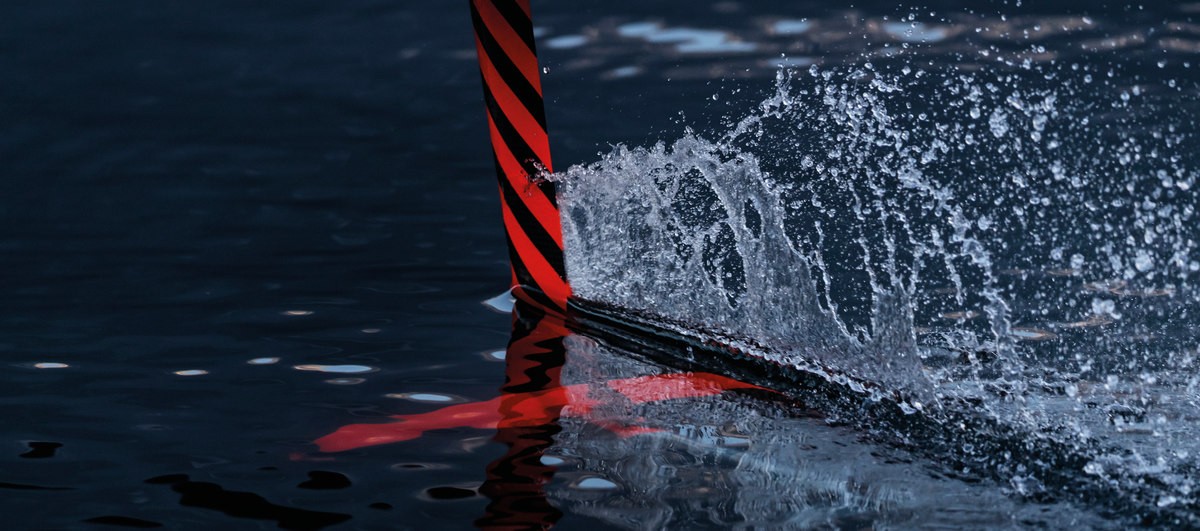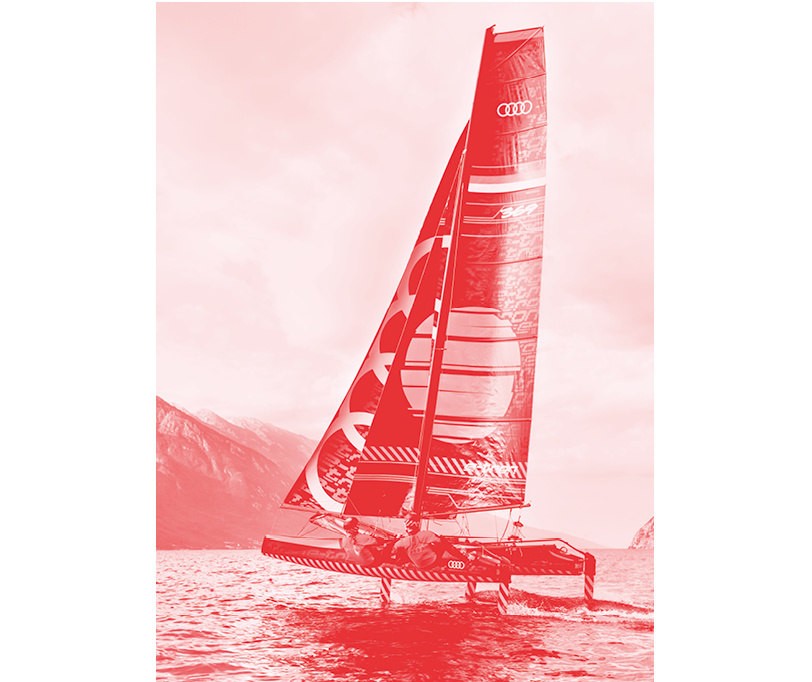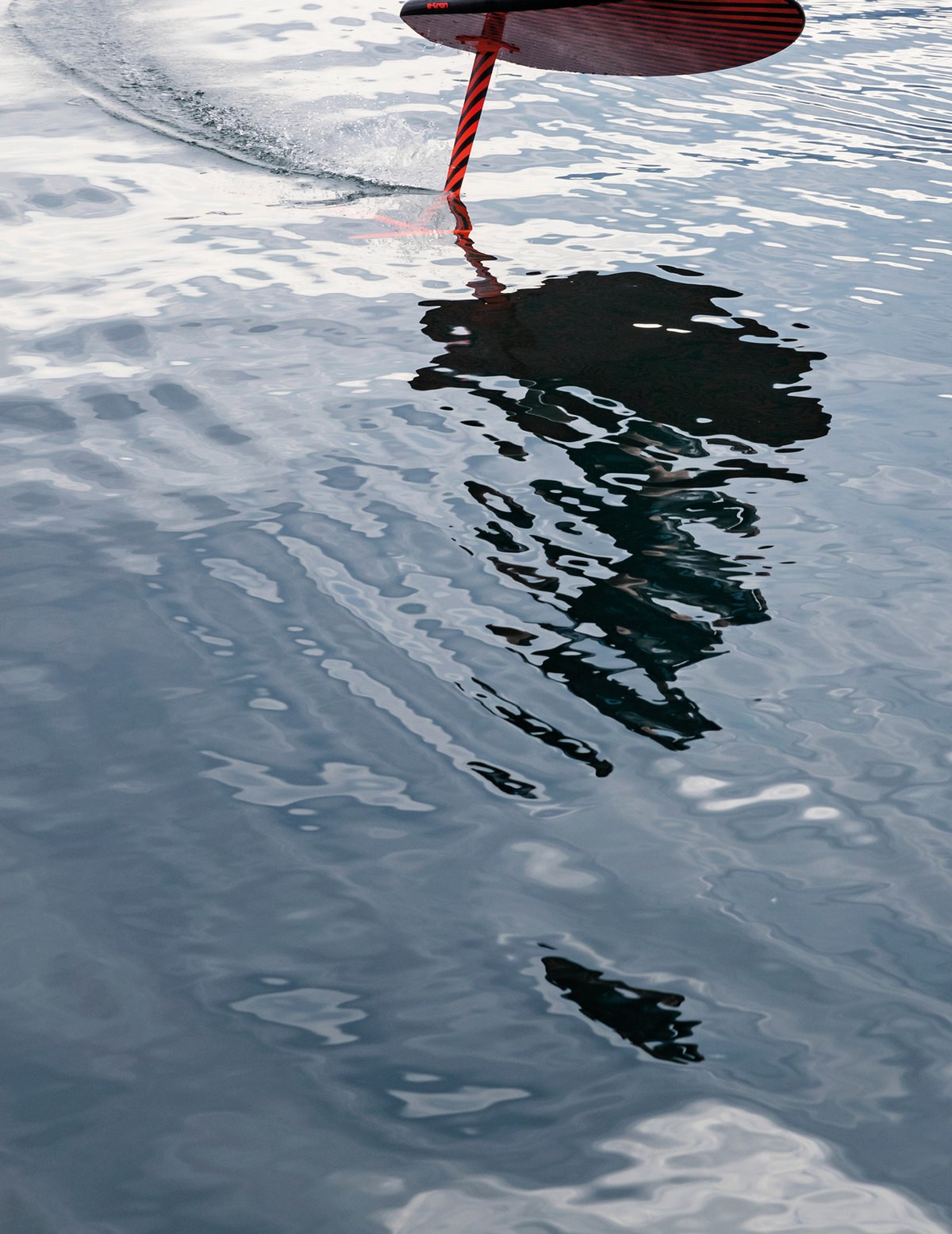
Unidentified flying object
e-tron conquers water vehicles: Audi engineer Franz Hofmann is developing a hydrofoil surfboard fitted with an electric jet-propulsion system.
Bernd Zerelles (copy) & Richard Walch (photo)

All at once, everything is blissfully calm. The water’s gurgling and lapping gives way to silence as the board rises and hovers a meter above the surface, like a flying carpet—supported by nothing more than a carbon mast at whose end is a foil which provides the necessary upthrust underwater to create this spectacle. Franz Hofmann balances skillfully on the board; in his hand is a remote control resembling the type used on electrically powered skateboards. The construction under his feet is called a foil (a type of wing), accelerated by an electric motor that Hofmann controls using his right index finger on the remote control. Is this the surfing of the future? Riding silently above the glass-clear water of an inland lake, devoid of any wave movement? For Hofmann, whose youthful face always exudes a certain mischievousness, there is no question that “this will be the revolution on lakes and in the sea.”
It’s a fact that one water-sport discipline after the other is succumbing to foiling fever. The America’s Cup, the top tier of sailing and a driving force in technology, made the switch from ponderous monohulls to huge foiling catamarans back in 2013. The Olympic Nacra 17 multihull class, in which Audi sailors Polgar and Werner compete, now sails on foils. Windsurfers use the foils to raise themselves above the water, as do kite surfers. The unique advantage of wind-powered craft equipped with foils is that as soon as the boat or board reaches a certain speed, the foil generates so much upthrust that it lifts the hull clear of the water. This achieves an enormous reduction in hydraulic friction, enabling high speeds even with very little wind. This was also how 33-year-old Franz Hofmann’s kitesurfing hobby led to his fascination with using foils to fly. Admittedly, the engineer’s job in developing hydrogen tanks at Audi means that he is working with the very same carbon fiber material used to make the mast and foil of a surfing foil. “When the first hydrofoils hit the market, I wasn’t impressed. I felt they were too expensive and difficult to purchase. But then again, I knew Chris,” smirks the Ingolstadt engineer. “Chris” is Christian Rössler, the brother of a childhood friend from their hometown near Hof in Bavaria’s Upper Franconia region. As well as winning multiple German championships, becoming world champion in 2006 and a world-record holder in pylon racing with the electric-powered model aircraft class F5D, he is first and foremost an aerospace engineer. He works as a research associate at the Institute of Aircraft Design at the Technical University of Munich (TUM), where he is responsible for the design of unmanned aerial systems. “We build demonstrators—or drones—and use them to test new technologies.” In other words, this is someone who knows a thing or two about flow technology.
“I wanted to build my own foil for kiting. A foil is ultimately just an underwater aircraft, and who can build aircraft better than Chris?” says Hofmann. Christian Rössler analyzed the relevant differences between air and water, made some initial calculations, simulated the flows for the hydrofoil—and came up with a totally unique design. The two of them constructed molds at TUM, perfected them in Chris’s living room before moving to the cellar, where they laminated their foil’s first carbon blades. That was in 2015. Since then, Hofmann has fitted this foil beneath his kiteboard at holiday locations across the globe—Cuba, Vietnam, Sri Lanka and Germany’s Baltic coast. “I always had a big grin plastered across my face. While people sipped cocktails on the beach and with just the slightest hint of a breeze, I was still able to kite with my foil.”

At Audi, the term “e-tron” refers to the company’s electrified vehicle drivetrains for tomorrow’s more eco-friendly transport. The long-term vision is CO₂-neutral mobility.

Audi supports the German sailing duo Polgar and Werner, who compete in the Olympic Nacra 17 class of foil-equipped multihulls. On special occasions, the team sails a custom-designed boat featuring the Audi e-tron look.

After a couple of days, anyone can foil on it.


Franz Hofmann tests the prototype Audi e-foil on Lake Garda. The battery is integrated into the board, the jet-propulsion system sits on the foil in the water, with Hofmann using a remote control in his right hand to regulate the speed.

Kai Lenny from Hawaii is one of the most famous and innovative watermen of our time. Not only has he surfed eleven waves in succession on his foil, he also foils on stand-up paddleboards. Search for: Kai Lenny hydrofoil.

Carbon also features in the material mix—along with alu-minum, steel and magnesium—in the new Audi Space Frame of the Audi A8. In addition, the rear panel of the Audi A8 is made of carbon, resulting in a roughly 50 percent weight reduction compared with its predecessor.
So far, so good. Then, however, the two friends asked themselves what to do next with their design or, as Hofmann describes it with more than a little pride, “one of the best and most efficient foils in terms of flow technology, based on data comparisons.” Both are deeply committed to their day jobs. “We had no ambitions to sell our product in the kiting, surfing or windsurfing market,” says Hofmann. But in the end, it was Hofmann’s engineering work at mobility company Audi that inspired the innovation that enables him to hover over the water today: “The drivetrain of the future? Mirroring the development of e-bikes in the bicycle segment, electric motors will soon be taking to the water across the board. Since a hydrofoil is simply enormously efficient, it made perfect sense to combine the two.” To this end, Hofmann set about presenting the concept to a diverse audience of colleagues at Audi: from innovation management and the design department all the way to colleagues in the field of 3D printing and several workshops. The unanimous response from all departments was that it was a fascinating idea that should be transformed into an Audi product.
At the start of the year, Hofmann’s first prototype took to the water: a kitesurfing board with a battery pack in a watertight case strapped to it. Achieved as early as spring, the next evolutionary stage boasted a battery compartment set into the board. At Kiel Week, the sailing event held each summer in the German Baltic city, the first pre-production boards—the brainchild of a colleague from Audi design—were on display on the beach. The pace of development is impressive, and Hofmann occasionally has to rub his eyes in astonishment at the large number of his colleagues who are now on board. “With the help of Audi, countless products are making their way into the foil and board, from plug-in connectors for the electronics all the way to the jet-propulsion system’s housing, which our 3D printing colleagues manufacture to our specifications.” This is one of the things that set the Audi e-foil apart: “We didn’t invent the e-foil, there are hundreds of DIY projects around the world. What we are doing, however, is combining our high-performance foil with jet propulsion. This is incredibly efficient and exceptionally safe.” Some of the electro-foils on the market are powered by an enclosed propeller—which is ultimately nothing other than a rotating blade that poses a high risk of injury particularly to small body parts. In contrast, the jet-propulsion system used on the Audi e-foil comprises an impeller, a small enclosed propeller that accelerates the water, and a stator placed immediately downstream that eliminates the swirl from the flow and ensures that the accelerated water flows in a straight line.
The key questions remaining are: When will interested parties be able to purchase the foil and how much will it cost? Franz Hofmann: “My vision is to build an initial limited production run in 2019 that can at first be used to offer our customers test rides. Current prices for electric hydrofoils are in the five-figure range.” But can anyone “drive” it, or do you need gymnastic skills? Hofmann stops short in amazement at the question and counters with complete conviction: “After a couple of days’ practice, virtually any amateur surfer will be flying over the water on it. It is easier than standing on a balance board in the gym. Watch me.” Franz grabs the remote control, jumps back onto his board and uses his index finger on the remote to apply power. “As soon as the board is gliding along, back off the power slightly, shift your weight onto your front foot and hold your position—just don’t pump the foil,” Hofmann shouts back to the shore. The board rests on the surface of the water for another couple of meters before rising up on the foil without any change in speed. It looks easy, almost playful. Only the thin carbon mast scythes through the water. Out on the lake, Hofmann accelerates his electro-hydrofoil toward the horizon. With no other vessel in sight at this time, it’s easy to grasp the sense of freedom that foiling offers.
Further photo credits: Andy Mann / Red Bull Content Pool, AUDI AG
